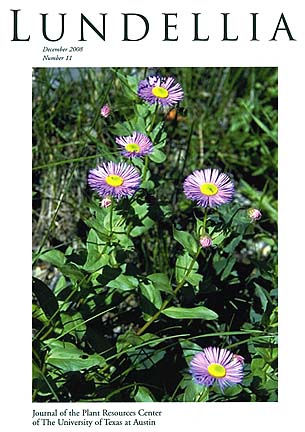
Journal of the Plant Resources Center of the University of Texas at Austin
Number 11 — December 2008
[Published: 10 December 2008]
Contents:
Abstracts
Revision of the genus Orbexilum (Fabaceae: Psoraleae)
Billie L. Turner
1—7
Abstract: Orbexilum Raf. is a wholly North American genus confined to the southeastern U.S.A. and Mexico. Grimes (1990) provided a revision of the complex in which eight species were recognized. Turner (2007) added two additional species, O. chiapasanum and O. oliganthum, these subsumed under the fabric of O. melanocarpum by Grimes. The latter worker also recognized a var. gracile of the widespread O. pedunculatum that in the present account I treat as a species, Orbexilum gracile. This brings to 11, the number of species currently recognized for the genus. Detailed descriptions and a key to the taxa are provided, along with maps showing their distributions.
Return to Vol. 11 Contents
Classification of Subtribe Conyzinae (Asteraceae: Astereae)
Guy L. Nesom
8—38
Abstract: Subtribe Conyzinae includes Erigeron, New World Conyza, the North American genus Aphanostephus, and a small group of South American species segregated as the genera Apopyros, Darwiniothamnus, Hysterionica, Leptostelma, and Neja. Erigeron is the only genus with species native to regions outside of the New World. About 500 species are included in the subtribe. All North American, Central American, and South American species of Erigeron are included in the present treatment and assigned to one of the 35 sections recognized here. Ten new sections of Erigeron are recognized: sect. Disparipili, sect. Filifolii, sect. Gyrifolium, sect. Lonchophylli, sect. Meridionales, sect Microcephalum, sect. Quercifolium, sect. Radicati, sect. Rhizonexus, and sect. Terranea. Conyza is at least biphyletic; each of the groups is represented in the treatment but not all of the South American species are included. Molecular data have made it clear that traditional, North American species of Erigeron form the basal and terminal clades in the evolutionary topology of the subtribe, thus Conyza, Aphanostephus, and the other segregate genera have arisen from within the branches of Erigeron. Erigeron, as currently treated and tentatively maintained here, is paraphyletic. Broad taxonomic alternatives that include only monophyletic taxa are: (1) to treat the whole subtribe as Erigeron or, (2) to recognize Aphanostephus or Aphanostephus, Conyza, and the other South American segregates and at least an additional 5 to 10 new generic-level segregates from species groups traditionally treated as North American Erigeron.
Return to Vol. 11 Contents
Heliotropium Addendum
Billie L. Turner
39—39
Abstract: A map adding Texas collections of Heliotropium powellorum and H. torreyi is given as an addendum to the distributions reported in Lundellia 10 (Dec 2007), Turner (p. 8).
Return to Vol. 11 Contents
 Lundellia Home Page
Lundellia Home Page
U. Texas at Austin | Plant Resources Center | Contact Us